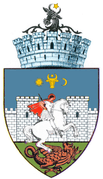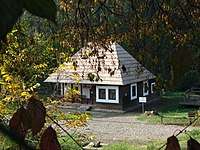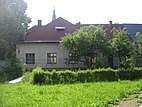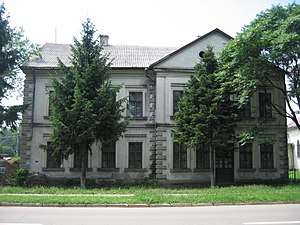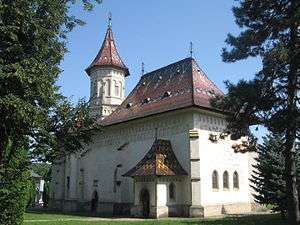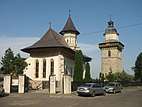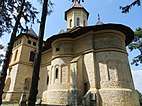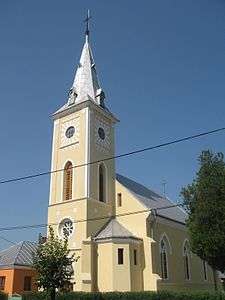Suceava
| Suceava | ||
|---|---|---|
| City | ||
   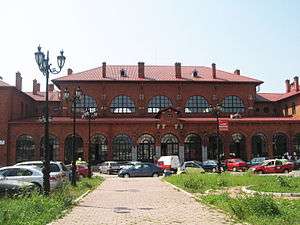     Left to right: the Administrative Palace, Palace of Justice, Bukovina History Museum, Burdujeni Train Station, The Medieval Seat Fortress, St. John the New Monastery, St. Apostles Church in Iţcani, St. John of Nepomuk Church | ||
| ||
 Suceava Location of Suceava  Suceava Suceava (Europe) | ||
| Coordinates: 47°39′05″N 26°15′20″E / 47.65139°N 26.25556°ECoordinates: 47°39′05″N 26°15′20″E / 47.65139°N 26.25556°E | ||
| Country |
| |
| County | Suceava County | |
| Status | County capital | |
| Government | ||
| • Mayor | Ion Lungu (National Liberal Party) | |
| Area | ||
| • City | 52.10 km2 (20.12 sq mi) | |
| • Metro | 473.29 km2 (182.74 sq mi) | |
| Population (2011 census)[1] | ||
| • City |
92,121 | |
| • Estimate (2016)[2] |
116,404 | |
| • Density | 1,771/km2 (4,590/sq mi) | |
| • Metro | 176,016[3] | |
| Time zone | UTC+2 (EET) | |
| • Summer (DST) | UTC+3 (EEST) | |
| Climate | Dfb | |
| Website | http://www.primariasv.ro/ | |
Suceava (Romanian: [suˈt͡ʃe̯ava]) is the largest city and the seat of Suceava County,[4] situated in the historical region of Bukovina from Central Europe[5] and north-eastern Romania respectively. The city was the capital of the medieval Principality of Moldavia from 1388 to 1565.[6][7]
Between 1775 and 1918, the city was the third largest urban settlement from the Duchy of Bukovina (German: Herzogtum Bukowina),[8] a constituent province of the Austrian Empire,[9] subsequently a crown land within Austria-Hungary, being only surpassed by Cernăuți (German: Czernowitz) and Rădăuți (German: Radautz) to the north.
Throughout this period of time, it fulfilled the task of an important, strategically-located commercial border town with the then Romanian Old Kingdom (German: Altreich), receiving a large influx of German-speaking settlers in the process (a community which has dwindled to a chiefly minor number nowadays).[10][11]
After 1918, along with the rest of Bukovina, Suceava became part of the enlarged Kingdom of Romania. Nowadays, it is a significant economic urban centre of the Romanian Nord-Est development region.
Names and etymology
Moldavian chronicler Grigore Ureche presumed the name of the city came from the Hungarian Szűcsvár, which is combined of the words szűcs (furrier, skinner) and vár (castle). This was taken over by Dimitrie Cantemir, who in his work Descriptio Moldaviae gave the very same explanation of the origin of the city's name, however, there are neither historical nor vernacular evidences for this. According to another theory, the city bears the name of the river with the same name, that is supposed to be of Ukrainian origin.[12]
In Old German the city was known as Sedschopff,[13] in modern German sources it can be found under such variations as Sotschen,[14][15] Sutschawa, or Suczawa, in Hungarian as Szucsáva[12] ([ˈsut͡ʃaːvɒ]) or Szőcsvásár, in Polish as Suczawa, in Ukrainian as Сучава (Sučava), while in Yiddish as שאָץ ([ʃɔts]).[16]
History

The present-day territory of the city of Suceava and the adjacent surroundings were already inhabited since the Paleolithic period. Stemming from the late Antiquity, there are also traces of Dacian oppidum of the 2nd century.
In stark contrast to several historical regions of Romania (most notably Transylvania and Oltenia), Suceava (along with the entire region of Bukovina for that matter) was not conquered by the legions of the Roman Empire and consequently was one of the lands of the Free Dacian tribes during the late Ancient Age. Nonetheless, according to Ptolemy, at that time in the region also dwelled two likely Celtic-speaking tribes, specifically the Anartes and the Taurisci,[17] as well as the Germanic Bastarnae, who have also been attested there.[18]
After the fall of Rome and during the Migration Period, the predominantly Carpiani population was successively invaded by East Germanic peoples (such as the Goths or the Gepids), Huns, Slavs, Magyars, Pechenegs, and ultimately Cumans. During the Late Middle Ages, the city of Suceava was the capital of the Principality of Moldavia and the main residence of the Moldavian princes for nearly two centuries (namely between 1388 and 1564).[19][20]
The city was the capital of the lands of Stephen the Great,[21] one of the pivotal figures in Romanian history, who died in Suceava in 1504. During the rule of Alexandru Lăpuşneanu, the seat was moved to Iaşi in 1565 and Suceava failed to become the capital again. Michael the Brave captured the city in 1600 during the Moldavian Magnate Wars as he became the ruler of Wallachia, Moldavia, and Transylvania, but he was defeated the same year.
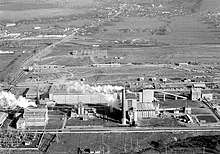
Together with the rest of Bukovina (German: Buchenland), Suceava was under the rule of the Habsburg Monarchy (and, later, the Austrian Empire as well as Austria-Hungary) from 1775 to 1918 (with the border of the Habsburg domains passing just south-east of the city).[22] During the late 19th century and early 20th century, the city was the third largest in the Duchy of Bukovina, after Cernăuți and Rădăuți.
At the end of World War I, it became part of Greater Romania. Throughout the interwar period, the city of Suceava (as it was concomitantly the case of the whole historical region of Bukovina) undergone further infrastructural development within the then enlarged Kingdom of Romania. It had also briefly belonged to Ținutul Suceava (between 1938 to 1940), one of the 10 lands established during King Carol II of Romania's reign.
Subsequently, from the 1950s onwards (along with the onset of Communism), Suceava was heavily industrialized and a significant series of historical buildings from its old city centre were demolished in order for Plattenbau-like blocks of flats to be constructed at the orders of the Communist officials.[23]
Geography
.jpg)
The city covers two types of geographical areas, the hills (of which the highest is Zamca Hill) and the meadows of the Suceava River valley. The unique setting of the urban settlement includes two groves, Zamca and Șipote, which are both located within the city limits. Burdujeni, one of the neighbourhoods, is connected to the rest of the city by a prominent avenue, which makes the neighbourhood appear to be a separate satellite town.
Demographics
| Historical population | ||
|---|---|---|
| Year | Pop. | ±% |
| 1912 | 11,229 | — |
| 1930 | 17,028 | +51.6% |
| 1948 | 10,123 | −40.6% |
| 1956 | 20,949 | +106.9% |
| 1966 | 37,697 | +79.9% |
| 1977 | 62,715 | +66.4% |
| 1992 | 114,462 | +82.5% |
| 2002 | 106,138 | −7.3% |
| 2011 | 92,121 | −13.2% |
| 2016 | 116,404 | +26.4% |
| Source: Austrian and Romanian census data and/or official estimates | ||
At the 1930 census, the recorded population amounted to c. 17,000 inhabitants with the following ethno-linguistic composition:[24]
- Romanians: 60.2%
- Germans (Bukovina Germans): 16.7%
- Jews: 15.4%
- Ukrainians: 3.7%
- Poles: 2.0%
As of 2011 census data, Suceava has a population of 92,121,[1] a decrease from the figure recorded at the 2002 census (106,138), making it the 23rd largest city in Romania. The ethnic makeup was as follows:
- Romanians: 98.3%
- Roma: 0.7%
- Ukrainians: 0.3%
- Germans (Bukovina Germans): 0.2%
- Poles: 0.1%
- Lipovans: 0.1%
- Others: 0.3%
Administration and local politics
List of mayors (1990–present)

The mayors who have administered the city since Romania's transition back to democracy and free market economy after the 1989 revolution were the following ones:
| Nº | Name | Term start | Term end | Political party |
|---|---|---|---|---|
| 1 | Filaret Poenariu | 1990 | 1992 | Independent |
| 2 | Gheorghe Toma | 1992 | 1996 | Ecologist Party of Romania (PER) |
| 3 | Constantin Sofroni | 1996 | 2000 | National Liberal Party (PNL)1 |
| 4 | Marian Ionescu | 2000 | 2004 | Social Democratic Party (PSD) |
| 5 | Ion Lungu | 2004 | present | National Liberal Party (PNL) |
Notes:
1 Initially voted on the lists of the Romanian Democratic Agrarian Party (PDAR) but subsequently switched to the National Liberal Party (PNL).[26]
City council
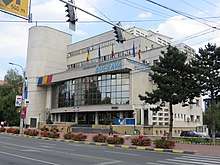
The city's current local council has the following multi-party political composition, based on the results of the ballots cast at the 2016 Romanian local elections:
| Party | Seats | Current Council | ||||||||||
|---|---|---|---|---|---|---|---|---|---|---|---|---|
| National Liberal Party (PNL) | 10 | |||||||||||
| Social Democratic Party (PSD) | 8 | |||||||||||
| Alliance of Liberals and Democrats (ALDE) | 3 | |||||||||||
| People's Movement Party (PMP) | 2 | |||||||||||
Culture
The Seat Fortress of Suceava

Suceava is the place of several medieval sites that are closely linked with the history of the former Principality of Moldavia. By far the most significant (and at the same time the most well preserved one) is the Seat Fortress of Suceava (Romanian: Cetatea de Scaun a Sucevei) or Suceava Citadel, a medieval castle situated on the eastern edge of the contemporary city.
The fortress was initially built during the reign of Petru of Moldavia (1375–1391), also known as Petru Mușat, being further expanded and strengthened during the reign of Alexander I of Moldavia (1400–1432) and Stephen the Great (1457–1504). The medieval castle was part of the fortification system built in Moldavia in the late 14th century, because of the emergence of the Ottoman danger. It became strong enough to hold off an attack by Ottoman sultan Mehmed II (the conqueror of Constantinople), in 1476.
Suceava was the capital city of the former Principality of Moldavia between 1388 and 1565. During this period, the castle served as princely residence. Alexandru Lăpușneanu had subsequently moved the Moldavian capital to Iași in 1565, so the castle lost its status. Afterwards, the citadel entered a period of steep decline. In 1675, during the reign of voivode Dumitrașcu Cantacuzino, the fortress was destroyed. Then, for over two centuries, the castle was completely deserted.
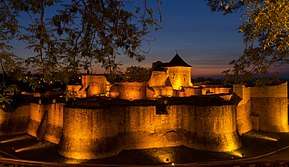
In late 19th century and early 20th century, under the patronage of Austrian architect Karl Adolf Romstorfer, there have been conducted a series of rehabilitation works and archaeological researches.[27] Between 1961 and 1970 other restoration and consolidation works were carried out. In 2013, a major reconstruction program was launched, to return the castle to its original architecture and shape.
The Seat Fortress of Suceava consists of two concentric citadels. The inner citadel, known as fortul mușatin, has a rectangular shape and a patio. It was built by Petru Mușat in late 14th century. In the second half of the 15th century, Stephen the Great expanded the structure, by adding another citadel that has a circular shape which surrounds the old one.
After 1476, new fortifications were added to the outer citadel. Furthermore, the whole castle is encircled by a large defensive ditch. Today, the fortress is a landmark of Suceava and a noteworthy touristic attraction. Since 2011, it has also been used for hosting cultural events such as the rock music festival Bucovina Rock Castle.[28]
The Princely Court of Suceava
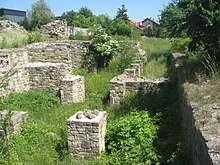
The Princely Court of Suceava (Curtea Domnească din Suceava) was built and developed related with the Seat Fortress. In late 14th century, voivode Petru Mușat built the Princely House, a structure made in wood, which included a cellar. After 1400, Alexander I of Moldavia rebuilt the wooden house and added a surrounding wall made of stone and a complex of buildings, also made of stone. In the second half of the 15th century, the Princely Court was severely affected by fire, the wooden house being completely burned out.
During his reign, Stephen the Great (1457–1504) restored the whole complex. A new Princely House was built, this time made of stone, and the other buildings were extended. Vasile Lupu (1634–1653) was the last ruler of Moldavia who took care of the Princely Court. During his time, the cellars were rehabilitated. The complex was abandoned in late 17th century, the buildings and the walls being gradually dismantled. Currently, on the site of the Princely Court there are only ruins and leftovers of the former buildings.
The ruins of the former medieval court are located in the city center of Suceava. In the 14th–17th centuries, in the proximity of the Princely Court there were built several churches that still exist today and attract tourists.
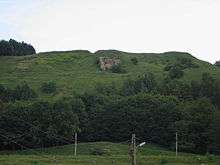
Șcheia Fortress
On the north-western edge of the modern city, on a hilltop, there is another medieval citadel known as Șcheia Fortress (Cetatea Șcheia) or the Western Fortress of Suceava (Cetatea de Apus a Sucevei). Unlike the Seat Fortress, currently Șcheia Fortress has left nothing but some ruins. The citadel was built during the reign of Petru Mușat in late 14th century, but was short-lived, because it was dismantled in early 15th century, during the reign of Alexander I of Moldavia. Șcheia Fortress, like the Seat Fortress, was part of the fortification system built in Moldavia in the late 14th century.
Museums
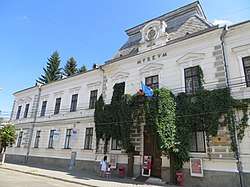
The first museum in Suceava was opened in 1900, by the initiative of some local intellectuals. In the beginning, the museum included only a few collections that were obtained as a result of the researches and excavation works at the Seat Fortress of Suceava. The museum was expanded and developed over time and became an important cultural institution, currently named Bukovina Museum (Muzeul Bucovinei). It has several departments and administers the medieval sites of the Seat Fortress, Șcheia Fortress and the Princely Court, local museums (Bukovina Village Museum, the history, ethnographic, and natural sciences museums), the memorial houses of Simion Florea Marian in Suceava, Nicolae Labiș in Mălini, Eusebiu Camilar in Udești, Ciprian Porumbescu in Stupca, and two traditional houses located in Solca and Bilca.
The oldest department of Bukovina Museum is the history museum, which was the backbone for creating a county museum at Suceava. This museum presents the local history of Suceava and Moldavia in the context of Romanian national history. The exhibits of the history museum and the offices of Bukovina Museum are located in a historic building, in the city center. The building, which hosted the prefecture of Suceava County during the interwar period, was built between 1902–1903. Since 1968, it houses the history museum. In 2014, the building and the museum entered an extensive program of modernization, rehabilitation, and expansion.
At the history museum there is a reconstitution of a scene from the former throne hall located in the Seat Fortress. The scene presents some notable people from the history of Moldavia, made in glass fiber: Stephen the Great (ruler of Moldavia), Maria Voichița (his third wife), Bogdan III the One-Eyed (his son and successor to the throne), officials of that time. The scene chosen to be reconstructed is an allotment of land for peasants. The reconstitution is based on medieval documents, frescoes and archaeological researches. Furthermore, the history museum periodically organizes a wide range of cultural events, several of which also involve the local branch of the Democratic Forum of Germans in Romania.[29][30]
Bukovina Village Museum (Muzeul Satului Bucovinean) is an open-air museum that highlights the traditional cultural and architectural heritage of Bukovina region. It is located in the eastern part of Suceava, near the Seat Fortress. It was founded in the 1970s, but its major expansion and development took place after 1990. The museum is designed as a traditional village in Bukovina, containing houses and various objectives from the ethnographic areas of Rădăuți, Humor, Câmpulung Moldovenesc, Dorna, and Fălticeni.
The museum includes among others a water mill from Mănăstirea Humorului, a traditional blacksmith workshop, a pottery workshop from Marginea and one of the many old wooden churches in northern Moldavia: Church of the Ascension, a Romanian Orthodox wooden church built in 1783 in Vama, a village in Suceava County. The bell tower is also made in wood, and dates from 1787. The church and the bell tower were both relocated in 2001, and currently are part of the museum.

Besides Bukovina Village Museum, another museum that reflects the traditional life in this part of Romania is the ethnographic museum. It was opened in 1968 and includes old collections and exhibits that are housed in a medieval inn located in the center of Suceava, known as the Princely Inn of Suceava (Hanul Domnesc din Suceava). This landmark dates from the late 16th and early 17th century. It was built of stone and has two floors and a cellar. During the Austrian rule (1775–1918), the inn operated as a hunting lodge for the imperial family. Since 1968, it hosts the ethnographic museum. The Princely Inn is the oldest civic building in Suceava which had not been seriously affected by time and maintained its original architecture.

The natural sciences museum was founded in 1976–1977, being the newest museum in Suceava. It highlights the flora and fauna of the surrounding area. The museum's rare exhibits and collections are housed in an old building, located in the central park of the city and built between 1811–1814. In the past, before being an attraction for visitors, the building operated as a school for boys.
Along with all these museums, Bukovina Museum includes memorial houses of some writers and artists born in this area of the country. The memorial house of Simion Florea Marian (Casa memorială Simion Florea Marian) is the only one located in Suceava, the other ones being in the surrounding area. The memorial house operates as a museum. It was opened in 1974 in the home where Romanian priest and writer Simion Florea Marian lived, from 1884 until 1907, when he died. The museum hosts a collection that contains over 10,000 volumes, over 450 collections of magazines and newspapers, of which 150 are from Bukovina, manuscripts, letters, cultural and historical documents, old photos. In front of the memorial house it was opened a small park with a statue dedicated to Simion Florea Marian.
Historical buildings
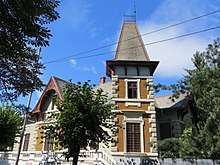
Colegiul de Artă Ciprian Porumbescu (Ciprian Porumbescu Art College) is a high school which is hosted in a historic building, built in 1859, in the city center of Suceava. The building had several destinations in the past: Suceava Town Hall (until 1904) and Școala primară română de fete (Primary Romanian school for girls). Romanian jazz singer Anca Parghel taught music for a living in Suceava at this local Arts high school before turning to a professional singing career in 1989.
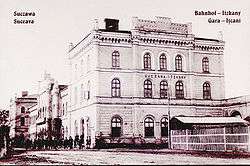
.jpg)
Gara Suceava Nord-Ițcani (Suceava North railway station, also known as Ițcani) is a train station built in 1871 in the village of Ițcani (today district of Suceava). Between 1871–1918, it was a train station at the Austro-Hungarian border. The historic building of Ițcani railway station was built in the Gothic style of the Central European railway stations of that period.
Palatul de Justiție (The Palace of Justice) is a historic building which was built in 1885 to serve as the seat of Suceava Tribunal and Court. The building has four sides and a patio, and was designed by Viennese architect Ferdinand Fellner. Later, during the communist regime, the city hall was moved in this palace and operated here until 2000.
Spitalul Vechi (The Old Hospital) is a complex of buildings built between 1891–1903 which originally hosted the district hospital. The hospital ensemble consists of four pavilions of historic value and was built in the southwestern end of Suceava, in Areni neighborhood. In 1964 a new hospital building (known as Spitalul Nou) was inaugurated nearby.
Colegiul Național Ștefan cel Mare (Ștefan cel Mare National College) is the oldest and most prestigious high school in Suceava County, established in 1860. The baroque style building which houses the high school was built between 1893–1895, downtown Suceava, and today is considered a historical monument.

Gara Suceava-Burdujeni (Suceava railway station, also known as Burdujeni) is a train station built between 1892–1902 in the village of Burdujeni (today district of Suceava). Between 1902–1918, it was a train station at the Austro-Hungarian border. The historic building of Burdujeni railway station was built in the architectural style of Fribourg railway station, located in Switzerland.
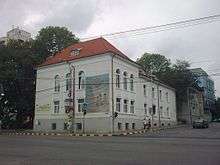
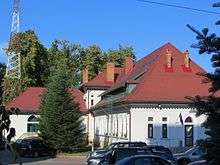
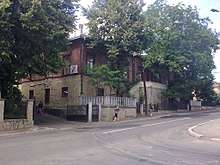
Palatul Administrativ (The Administrative Palace) is a historic building which was built between 1903–1904 to serve as the seat of Suceava City Hall. The building originally had only two sides of the four current sides, and was designed by Viennese architect Peter Paul Brang. It was designed in the baroque style. Currently, the palace houses the prefecture and the county council of Suceava County.
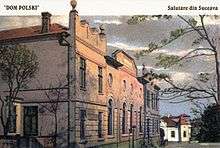
Casa Polonă (The Polish House) is a building made between 1903–1907 by the Polish community in the city of Suceava. The building was designed by architect Alojz Friedel. During the communist regime, The Polish House was nationalized, and since 1954, it housed Ansamblul Artistic Ciprian Porumbescu (Ciprian Porumbescu Artistic Ensemble). In 1984 the building was restored, and then hosted a local theatre, until 1990. In 1996, the building was returned to the Polish community of the city.
Uzina de Apă (The Water Plant) is a set of industrial heritage buildings, designed in 1908 by engineer G. Thiem from Leipzig and built between 1910–1912.[31] The water plant operated in these buildings between 1912–1960, and then it was moved into a modern building. In 2012, in celebration of 100 years since its establishment, in the former water plant buildings there was inaugurated the Centre for Architecture, Urban Culture and Landscape in Suceava.
Biblioteca Bucovinei I.G. Sbiera (I.G. Sbiera Bukovina Library) is the first public library in Suceava, inaugurated on 12 December 1923. It is also the largest library in Suceava County, with over 350,000 bibliographic units. Currently, the library is hosted by two historic buildings located in downtown Suceava and built between 1925–1926, respectively 1929–1930.
The County Forestry Department in Suceava is an institution which operates in a heritage building located in Areni neighborhood, in the city of Suceava. The building dates from the first half of the 20th century.
The Unions House in Suceava is a heritage building, located in downtown Suceava, which houses the unions offices, along with some shops. The building is also known as Samuil Isopescu House.
Casa Costin Tarangul (Costin Tarangul House) is a heritage house dating from the 19th century (1886). The building is located next to Simion Florea Marian Memorial House, in the center of Suceava.
Casa Ciprian Porumbescu (Ciprian Porumbescu House) is a heritage house dating from the 19th century, where Romanian composer Ciprian Porumbescu lived and created some of his works. The house is located in Prunului street, downtown Suceava.
School No. 5 Jean Bart in Burdujeni (Suceava) is a school built in 1902 in the village Burdujeni, today a town district of Suceava. The building that houses the school has historic value.
School No. 6 in Burdujeni-Sat (Suceava) is a school built in 1911 in the village Burdujeni, today a town district of Suceava. The building that houses the school has historic value.
Former Burdujeni Town Hall in Suceava is a building that was built in 1902 in the village Burdujeni and initially was the town hall of the locality. In 1926 Burdujeni became a district of Suceava, and so the town hall was abolished. The historic building currently houses the headquarters of Electrica company.
Ițcani neighbourhood
Ițcani (German: Itzkany) is a neighbourhood located several miles northwest of the city centre. Initially established as a small village in the 15th century under the rulership of Alexăndrel of Moldavia, it subsequently expanded as a German-speaking colony much later, specifically starting in the late 19th century, seeing an influx of German settlers during the Josephine colonization (German: Josephinische Kolonisation) which took place in the time of the Austrian Empire.[32][33] The north railway station (which depicts architectural elements of both Gothic revival and Neo-romanticist styles, also the oldest in the city) is situated in this neighbourhood as well.
Monuments
Near the fortress, in Șipote-Cetate Park, there is an equestrian statue of Stephen the Great, designed and made by the local sculptor Iftimie Bârleanu in 1977. The monument has 23 meters in height, being the tallest equestrian statue in Romania. In the city centre there's also a statue dedicated to Petru Mușat, Prince of Moldavia between 1375–1391.
Religious buildings
Romanian Orthodox churches
One of the most important cultural sites in Suceava is Saint John the New Monastery which includes the monumental Church of Saint George, built between 1514 and 1522. The construction began during the reign of voivode Bogdan III the One-Eyed of Moldavia, after the nearby Mirăuți Church (the metropolitan cathedral of Moldavia at that moment) was devastated in 1513. The construction was completed by Stephen IV of Moldavia (also known as Ștefăniță). The monastery church served as metropolitan cathedral of Moldavia until 1677. It has frescoes painted on the outside, typical of the region, and is one of eight buildings that make up the churches of Moldavia UNESCO World Heritage Site.[34] Since 1991 Saint John the New Monastery serves as the cathedral of the Archdiocese of Suceava and Rădăuți. Saint John the New[35] was a Moldavian monk who preached during Turkish occupation and was subsequently martyred in Cetatea Albă, present-day Bilhorod-Dnistrovskyi in Ukraine. Alexander I of Moldavia brought his relics to Suceava in 1402.
Mirăuți Church, dedicated to Saint George, is the oldest religious building in Suceava, founded by Petru II of Moldavia in late 14th century, in the same period with the Seat Fortress, when he moved the capital from Siret to Suceava. The church established the city as a see of it. Mirăuți was the metropolitan cathedral of Moldavia between 1402 and 1522, when the church of Saint John the New Monastery was completed. In 1402, the relics of Saint John the New were transferred to this church from Cetatea Albă, and then, in 1589 transferred again to the nearby monastery church by voivode Peter the Lame. The name Mirăuți derives from the fact that it was the coronation church of Moldavia until 1522. Stephen the Great was crowned in here in 1457. After the church was devastated, it was rebuilt in early 17th century, and then, in the 18th century, abandoned.
Church of Saint Demetrius was founded by Peter IV Rareș, ruler of Moldavia (1527–1538, 1541–1546), and the son of Stephan the Great. The church was built in 1534–1535, with a bell tower added in 1560–1561 by Alexandru Lăpușneanu. The bell tower is 40 meters high, being the tallest bell tower in Suceava and a landmark of the city. The church had frescoes painted on the outside, that are still visible on one side wall. The frescoes inside were restored recently. Church of Saint Demetrius is located near the ruins of the former Princely Court of Suceava.
Furthermore, there is another old church near these ruins. Church of Saint John the Baptist, also known as Coconilor Church or Domnițelor Church, was founded in 1643 by Vasile Lupu, voivode of Moldavia between 1632 and 1653. It has no exterior frescoes and a short bell tower that has its roof linked with the roof above the church. In its early days, the church functioned as a chapel for the Princely Court.
Church of the Resurrection (located in the proximity of Saint John the New Monastery) dates from 1551, and was founded by Elena Rareș, the wife of voivode Peter IV Rareș. The church has no tower above the naos, its architecture reflecting the urban style of the medieval period. Instead of the bell tower, the church has a zvonnitsa, an architectural form especially used in the Russian architecture of the 14th–17th centuries. Church of the Resurrection was used by the local Roman Catholic community during the Habsburg occupation, and then by the Ruthenian Greek Catholic community, until 1936. It is also known as Văscresenia Church or Elena Doamna Church.
Church of Saint Nicholas (Prăjescu) is another religious building in Suceava that features the medieval Moldavian architectural style. The present church was rebuilt by treasurer Nicoară Prăjescu in 1611, during the reign of Constantin Movilă (1607–1611). Throughout its history, the church functioned as a necropolis for the local boyars.
Between the city center and Ițcani neighborhood, on the slopes that descend to Suceava River valley, there is Church of the Assumption, another old Romanian Orthodox church, founded in the first half of the 17th century (1639). The church was built on the place where Ițcani Monastery existed before. It functioned as a nunnery until late 18th century. Today it is parish church, and has a zvonnitsa similar to that of Church of the Resurrection, located downtown.
In Burdujeni neighborhood, 4 km (2 mi) north-east of the city center, there is Teodoreni Monastery, founded in 1597 by local boyar Teodor Movilă, the elder brother of Ieremia Movilă, ruler of Moldavia (1595–1600, 1600–1606). Burdujeni village (now a district of Suceava) was established and developed around this monastery. The set of buildings includes Church of Ascension, the bell tower, living quarters for nuns and a surrounding wall. Just 1 km (0.6 mi) north of Teodoreni Monastery, in the old district of Burdujeni, there is Church of the Holy Trinity, founded by archimandrite Filaret Scriban in 1851.
Ițcani neighborhood has two Romanian Orthodox churches founded in the first half of the 20th century: Church of the Holy Archangels (built near Suceava North railway station, in 1933–1938) and Church of the Holy Apostles (located on European route E85 and built in 1905–1908 by the German community of Ițcani, initially as a Lutheran church).
Church of the Holy Cross, located in Pătrăuți village (a few miles north-west of Ițcani), was founded in 1487 by Stephen the Great, and is one of the monuments that make up the churches of Moldavia UNESCO World Heritage Site. Also not far away from Ițcani, there is Dragomirna Monastery, established by clergyman Anastasie Crimca in 1609. Voroneț Monastery is located 40 km (25 mi) west of Suceava, in the town of Gura Humorului.
German Roman Catholic and Lutheran churches
During the late Modern Age until the mid 20th century a sizable German community lived in Suceava, making up almost a quarter of the total population of the city in the 1900s. They were of both Roman Catholic and Evangelical Lutheran faith given the fact that they had a rather diverse geographic origin.[36]
As such, these German-speaking citizens that were settled by the Austrian Empire in the city stemmed most notably from present-day southern Germany, Austria, and Bohemia, both Catholics and Protestants.[37] Several religious buildings that served both aforementioned religious denominations can still be found today both in the city proper and in the Ițcani neighborhood, where a once numerous German-speaking community stemming from contemporary Rhineland-Palatinate land once lived.[38]
Armenian Orthodox churches
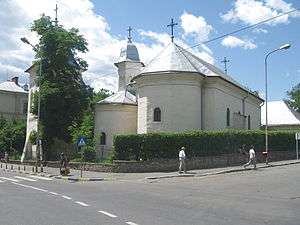
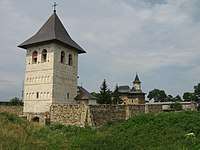
In the past, Suceava used to have an important Armenian community as well. Their cultural and historical legacy is highlighted by a series of well preserved religious buildings that still exist to this today.
The most representative ecclesiastical landmark established by the local Armenian population is Zamca Monastery (the term Zamca can actually trace its linguistic origin to Polish, denoting as such a 'fortified place' and being named this way by King Jan Sobieski of Poland in 1691), a fortified complex of buildings located on a plateau at the western point of the contemporary city.[39]
Zamca Monastery was constructed between 1551 and 1606 and its church is dedicated to Saint Auxentius. Along with the church, the monastery includes several buildings made of stone and a defensive wall that surrounds the whole medieval complex.
Between Zamca Monastery and the city center there are two more Armenian Orthodox churches. Church of Saint Simon (also known as The Red Tower Church because of its bell tower) was founded in 1513. The bell tower was constructed in 1551.
The church has an old Armenian cemetery in the proximity and a chapel that was built in 1902 (Pruncul Chapel). Church of the Holy Cross was established in 1521 and was renovated several times in its history. The Armenian parsonage is located near the church, along with several old tomb stones.
Hagigadar Monastery is another medieval complex built by the local Armenians. It was founded in 1512–1513, and is located on the south-western proximity of the city, on a valley near European route E85.
Tourism
In the past few years Suceava started to evolve more rapidly. The most important sights in the town date from its time as a princely capital (i.e. the Middle Ages).
There are numerous museums in the city including the Bucovina History Museum, the Bucovina Village Museum,[40] the Bucovina Ethnographic Museum (housed in an inn dating from the 17th century),[41] or the Natural History Museum.
Sports
Football
ACS Foresta Suceava (Romanian: Asociația Club Sportiv Foresta Suceava), formerly known as Rapid CFR Suceava, is the football team that currently represents the city of Suceava in the third tier of the Romanian football system, more specifically in Liga III.
In the past, the city has also had other significant football clubs competing in either Liga I or Liga II (depending on their level of performance) such as CSM Suceava, Cetatea Suceava, or Foresta Suceava (the latter one being initially based in the city of Fălticeni from the same county). The city also used to have another Liga III side called Sporting Suceava, but due to financing reasons the club had subsequently went bankrupt and ceased playing.
All the major sporting events are hosted on the Areni Stadium, a multi-purpose stadium in Suceava. It is currently the home ground of ACS Foresta Suceava and can hold up to 12,500 people. The stadium was initially opened in 1963 as the "Municipal Stadium".
Handball
CS Universitatea Bucovina Suceava is the city's men's handball team which currently competes in the Romanian Handball League (Romanian: Liga Națională).[42] It was founded in 2002 and it started playing in the first tier of the Romanian handball system in 2006. In 2011 it achieved its greatest performance to date, namely finishing 3rd in the national handball division.
Schooling and education
The main university of the city (and also of the entire county) is the Ștefan cel Mare University of Suceava established in 1990, which has 10,138 students to date.

The most prominent high schools with theoretical pathway are as follows:
National College "Mihai Eminescu" Suceava[43]
- Named after the most well-known Moldavian and Romanian poet, Mihai Eminescu
- Main study offers are: Social Sciences, Mathematics and Informatics, Philology.
National College "Petru Rareș" Suceava[44]
- Named after the voievod of Moldavia, Peter IV Rareş
- Main study offers are: English, Philology, Mathematics and Informatics.
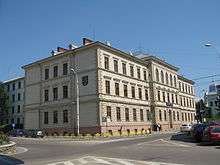
National College "Ștefan cel Mare" Suceava[45]
- Named after the prince of Moldavia between the years 1457 and 1504, Stephen III of Moldavia
- Main study offers are: Natural Sciences, Mathematics and Informatics.
Economical College "Dimitre Cantemir" Suceava[46]
- Named after the twice Prince of Moldavia and the famous writer of the Descriptio Moldavie, Dimitrie Cantemir.
- It is the only economics high-school in Suceava.
- Main study offers are Tourism, Gastronomy, Alimentation, Economy, Countability and Trade.
- The main profile which the school promovates is the Technical profile.
Transportation
Air
Suceava is served by the Suceava International "Ştefan cel Mare" Airport (SCV), located 12 km (7.5 mi) east of the city centre, in Salcea.[47] As of 2017, it had an annual traffic of 262,165 passengers, a local record thus far, making it the 8th busiest airport in Romania.[48]
Natives
-
- Marius Babias, art critic, author, and curator (director of Neuer Berliner Kunstverein since 2008)
- Ludwig Adolf Staufe-Simiginowicz, poet and German language teacher
- George Ostafi, abstract painter
- Ioana Rostoș (nom de plume Jane Rostos), writer
- Eugeniu Botez (nom de plume Jean Bart), writer
- Stela Cheptea, historian and medievalist
- Ioan Nemeș, physicist and biologist
- Norman Manea, writer and intellectual
- Pamfil Polonic, archaeologist and topographer
- Gheorghe Panaiteanu Bardasare, painter
- Iosif Berman, photographer and journalist during the interwar period
- Vladimir Găitan, actor
- Nicolae Picu, violinist
-
- Dorin Goian, former football player and coach
- Cristian Mugur Bolohan, former football player and coach
- Cosmin Pașcovici, former football player
- Daniel Bălan, football player and coach
- Lucian Goian, football player
- Mihai Roman, football player
- Cătălin Golofca, football player
- Paul Mateciuc, football player
- Doru Popadiuc, football player
- Alexandru Buziuc, football player
- Lidia Havriștiuc, football player
- Tiberiu Serediuc, football player
- Aleksandru Longher, football player
- Sonia Ursu-Kim, basketball player
- Petru Bălan, rugby union footballer
- Ionuț Dimofte, rugby union football player
- Iulian Dumitraș, rugby union football player
- Ovidiu Slușariuc, former rugby union football player
- Irina Dorneanu, Olympic rower
-
- Anastasie Crimca, 16th century Eastern orthodox clergyman, calligrapher, illuminator, and writer
- Dimitrie Barilă, 17th century Moldavian Metropolitan, scholar, poet, and translator
- Peter Mogila, 17th century theologian
- Filaret Scriban, 19th century theologian
- Iosif Bobulescu, 19th century bishop
- Shulem Moskovitz, chasidic Rebbe
- Meir Shapiro, Hasidic rabbi and rosh yeshiva
-
- Cristian Adomniței, former PNL Minister of Education (2007–2008)
- Eugen Bejinariu, former PSD acting Prime Minister (2004)
See also
International relations
Twin towns — Sister cities
Suceava is twinned with:
Regional, cultural, and economic partnerships
In addition to the official town/city twinning, the city of Suceava shares a series of regional, cultural, and economic partnerships with the following:[55]
|
Consulates

Gallery
 The Administrative Palace (view of the front façade)
The Administrative Palace (view of the front façade) The Palace of Finance
The Palace of Finance- The Justice Palace in the city centre
 The Old Hospital
The Old Hospital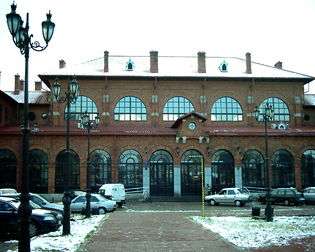 Burdujeni railway station in wintertime
Burdujeni railway station in wintertime Ciprian Porumbescu Art College (former German-language gymnasium)
Ciprian Porumbescu Art College (former German-language gymnasium) 22 December square in downtown Suceava
22 December square in downtown Suceava Downtown Suceava, as seen from the medieval Seat Fortress (December, 2005)
Downtown Suceava, as seen from the medieval Seat Fortress (December, 2005)_from_Fortess.jpg) Downtown Suceava, as seen from the medieval Seat Fortress (August, 2009
Downtown Suceava, as seen from the medieval Seat Fortress (August, 2009- Aerial view of the Seat Fortress (June, 2015)
 Statue of Petru Mușat, Prince of Moldavia (between 1375–1391)
Statue of Petru Mușat, Prince of Moldavia (between 1375–1391) The equestrian statue of Stephen III of Moldavia
The equestrian statue of Stephen III of Moldavia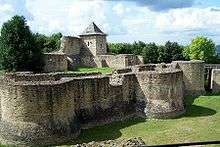 The Seat Fortress (August, 2009)
The Seat Fortress (August, 2009).jpg) Panoramic view of the Seat Fortress of Suceava as seen in August, 2016
Panoramic view of the Seat Fortress of Suceava as seen in August, 2016 Hotel Bucovina
Hotel Bucovina Emergency County Hospital Saint John the New in Suceava
Emergency County Hospital Saint John the New in Suceava The Park of the Flags (Romanian: Parcul Drapelelor), displaying all of the EU states' national flags
The Park of the Flags (Romanian: Parcul Drapelelor), displaying all of the EU states' national flags IFA Tower, the city's tallest structure (with a total height surpassing 200 metres)
IFA Tower, the city's tallest structure (with a total height surpassing 200 metres)
References
- 1 2 "2011 Census" (PDF) (in Romanian). INSSE. February 2, 2012. Archived from the original (PDF) on June 4, 2013. Retrieved March 12, 2012.
- ↑ "Populaţia României pe localitati la 1 ianuarie 2016" (in Romanian). INSSE. 6 June 2016. Retrieved 27 October 2017.
- ↑ "Population on 1 January by age groups and sex - functional urban areas" (PDF) (in Romanian). INSSE. Retrieved 29 October 2017.
- ↑ "Encyclopaedia Britannica - County of Suceava".
- ↑ Klaus Peter Berger, The Creeping Codification of the New Lex Mercatoria, Kluwer Law International, 2010, p. 132
- ↑ Daniel Onea, Adina Olaru (27 January 2016). "Suceava – die geschichtsbeladene Stadt in der Bukowina (in German)". Radio România Internațional. Retrieved 1 October 2018.
- ↑ Lani Seelinger. "The 10 Most Beautiful Towns In Romania". The Culture Trip. Retrieved 28 August 2018.
- ↑ Alexander Weidle (10 December 2017). "Bukowina Deutsche (in German)". University of Augsburg. Retrieved 1 October 2018.
- ↑ Țurcaș, Ioan, Lucian, Macarie. "German Language and Culture in Southern Bukovina. The Disappearance of a Cultural Enclave" (PDF). Abstract of PhD thesis. Retrieved 1 October 2018.
- ↑ www.pausenradio.net (25 October 2015). "Porträt der Deutschen Minderheit - Geschichte zum Nachhören (in German)". Pausen Radio. Retrieved 1 October 2018.
- ↑ Robert Tari (20 September 2015). "Geschichte einer Minderheit noch nicht zu Ende geschrieben (in German)". Allgemeine Deutsche Zeitung für Rumänien, www.adz.ro. Retrieved 1 October 2018.
- 1 2 Hoffmann, István (2008). Helynévtörténeti tanulmányok 3. Debrecen: University of Debrecen, Department of Hungarian Linguistics. p. 212. ISBN 978-963-473-115-3.
- ↑ Hans Schiltbergers Reisebuch nach der Nürnberger Handschrift.. Litterarischer Verein in Stuttgart, Tübingen 1885, Seite 189.
- ↑ Hermann Adalbert Daniel: "Handbuch der geographie" ('Geography Handbook') (1866)
- ↑ Peter Kosta (Hrsg.): Eine russische Kosmographie aus dem 17. Jahrhundert: sprachwissenschaftliche Analyse mit Textedition und Faksimile, Otto Sagner, 1982. ISBN 3-87690-200-2
- ↑ For Yiddish spelling and pronunciation, see "Shotzer - the book of the Jews of Suceava" ISBN 965-7226-16-3
- ↑ Ptolemy III.8.5
- ↑ Barrington Map 22
- ↑ "Encyclopaedia Britannica - City of Suceava".
- ↑ Muzeul Bucovinei. "Muzeul Bucovinei - Princely Fortress of Suceava (in Romanian)".
- ↑ Bukowina Freunde. "Die Bukowina". www.bukowinafreunde.de (in German). Retrieved 1 October 2018.
- ↑ "Minoritatea germană din România de Winfried Ziegler (in Romanian)" (PDF). Goethe Institut. Retrieved 16 June 2018.
- ↑ The Rough Guide to Romania, ISBN 978-1-84353-326-9
- ↑ "Recensămânul general al populației României din 29 decemvrie 1930".
- ↑ www.adevarul.ro (29 January 2015). "Primarul austriac care a adus energia electrică, iluminatul public, alimentarea cu apă, canalizarea şi străzile asfaltate în Suceava". Ziarul Adevărul. Retrieved 22 June 2018.
- ↑ www.crainou.ro (18 March 2005). "Fostul primar Constantin Sofroni, cetățean de onoare post-mortem". Crai Nou. Retrieved 22 June 2018.
- ↑ Romstorfer, vienezul care a îndatorat Bucovina (in Romanian)
- ↑ Bucovina Rock Castle official website (in Romanian)
- ↑ www.istorielocala.ro (14 October 2013). "Forumul Democrat al Germanilor din Bucovina (in Romanian)". Istoria Locală @ biblioteca ta publică. Retrieved 16 June 2018.
- ↑ www.adz.ro (8 January 2014). "Die Geschichte der Deutschen in Rumänien wurde noch nicht zu Ende geschrieben (in German)". Allgemeine Deutsche Zeitung für Rumänien. Retrieved 1 October 2018.
- ↑ www.miesarch.com. "Water Plant, Center for Architecture, Urban Culture and landscape". Fundació Mies van der Rohe. 2018. Retrieved 16 June 2018.
- ↑ www.bukovinasociety.org. "The Regional Distribution of the Germans in Bukovina". The Bukovina Society of the Americas. Retrieved 16 June 2018.
- ↑ www.bukovinasociety.org. "The Golden Bistritz - The Settlement of German Population Groups in Bukovina". The Bukovina Society of the Americas. Retrieved 16 June 2018.
- ↑ Churches of Moldavia at the UNESCO site
- ↑ sfantulioancelnou.8k.ro Archived 2009-12-27 at the Wayback Machine.
- ↑ www.bukowinafreunde.de. "Bukovina and its Bukovina Germans by Willi Kosiul" (PDF). Bukowina Freunde. Retrieved 16 June 2018.
- ↑ www.bukovinasociety.org. "The History of Bukovina by Dr. Sophie A. Welisch". The Bukovina Society of the Americas. Retrieved 16 June 2018.
- ↑ www.monitorulsv.ro. "Viaţa germanilor bucovineni din Iţcanii Noi". Monitorul de Suceava. Retrieved 16 June 2018.
- ↑ Isabela (2 October 2013). "Descoperă orașul Suceava (in Romanian)". călătoresc.ro. Retrieved 28 September 2018.
- ↑ www.monitorulsv.ro. "Muzeul Satului Bucovinean". Muzeul Bucovinei. Retrieved 16 June 2018.
- ↑ "Muzeul Etnografic Hanul Domnesc (in Romanian)". Orașul Suceava. Retrieved 28 September 2018.
- ↑ "Echipa - Istoric" (in Romanian). csusuceava.ro. Archived from the original on 30 August 2013. Retrieved 31 May 2011.
- ↑ "Colegiul Național "Mihai Eminescu" din Suceava". Retrieved 17 June 2018.
- ↑ "Coleiul Național "Petru Rareș" din Suceava". Retrieved 17 June 2018.
- ↑ "Colegiul Național "Ștefan cel Mare" din Suceava". Retrieved 17 June 2018.
- ↑ "Colegiul Economic "Dimitrie Cantemir" Suceava". Retrieved 17 June 2018.
- ↑ LRSV location Archived 2016-03-25 at the Wayback Machine.
- ↑ "Traficul pe Aeroportul „Ștefan cel Mare" Suceava a atins în 2017 un record istoric". newsbucovina.ro.
- ↑ www.monitorulsv.ro (4 July 2009). "Sucevenii s-au înfrăţit cu chinezii din Guizhou". Monitorul de Suceava. Retrieved 9 June 2018.
- ↑ www.monitorulsv.ro (8 April 2010). "Suceava a început demersurile de înfrăţire cu oraşul israelian Haifa". Monitorul de Suceava. Retrieved 13 June 2018.
- ↑ www.newsme.ro (20 October 2010). "Suceava înfrățită cu orașul francez Laval". newsMe. Retrieved 9 June 2018.
- ↑ www.primariasv.ro. "Orașul Sosnowiec – Polonia" (PDF). Primăria Municipiului Suceava. Retrieved 9 June 2018.
- ↑ Radio Chișinău (8 February 2018). "Maluri de Prut: La 630 de ani de la prima atestare documentară, Suceava se înfrățește cu Soroca. Două orașe-cetăți cu legături istorice profunde". Radio Chișinău. Retrieved 10 February 2018.
- ↑ www.primariasv.ro. "Regiunea Cernăuţi este situată în zona Munţilor Carpaţi din sud-vestul Ucrainei" (PDF). Primăria Municipiului Suceava. Retrieved 9 June 2018.
- ↑ "Primăria Suceava - Despre orașul Suceava (in Romanian)".
- ↑ Anca Bernovici (25 May 2018). "Ambassador Cord Meier-Klodt: German investors are looking for new opportunities in Romania". The Romania Journal. Retrieved 17 June 2018.
External links
| Wikimedia Commons has media related to Suceava. |
| Wikivoyage has a travel guide for Suceava. |
